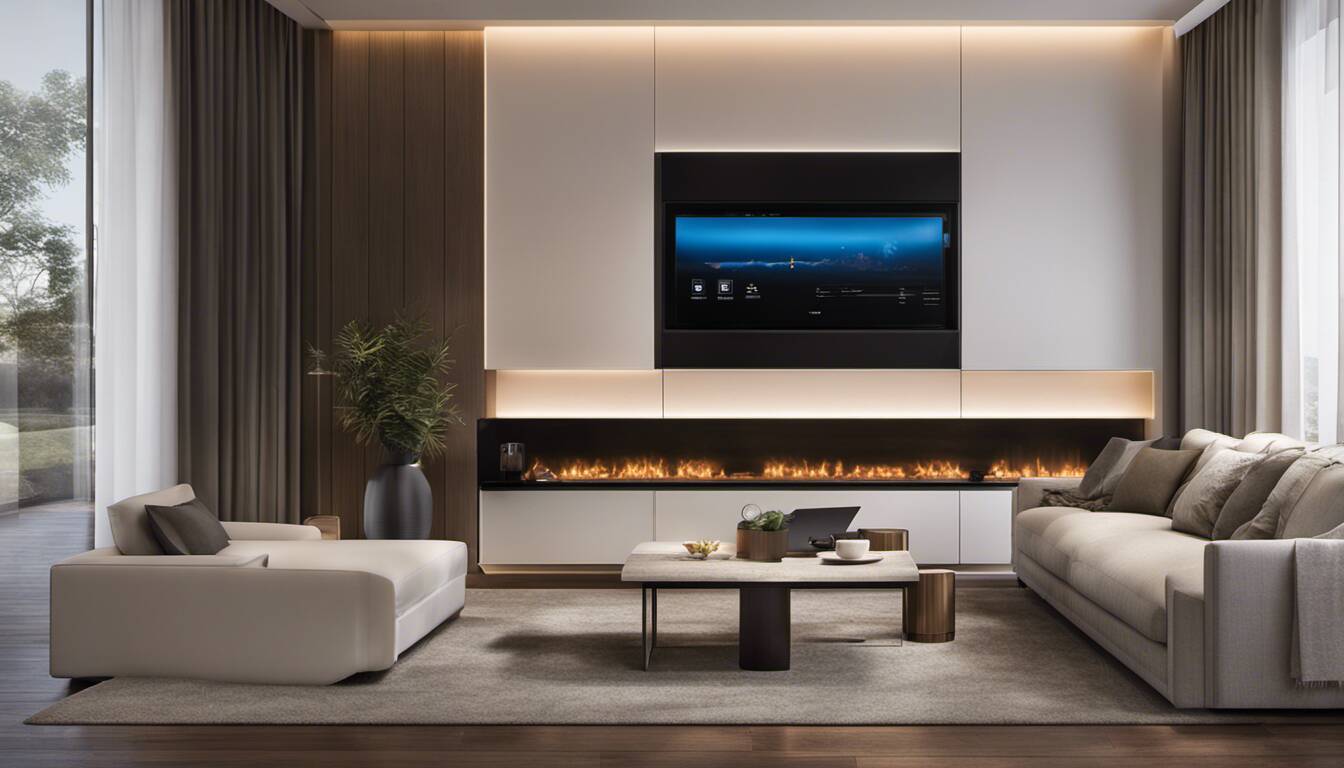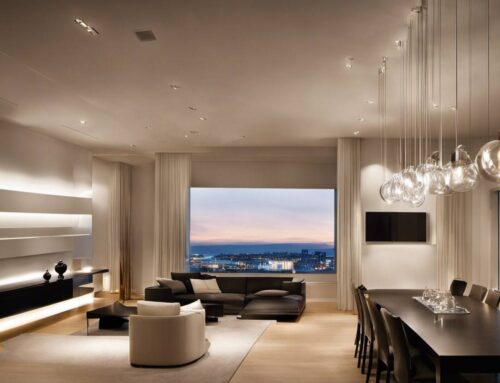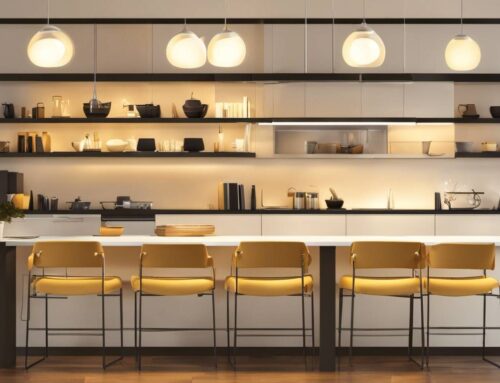Dive into the fascinating world of illumination where science meets incredible design. Your clear guide to understanding and unlocking the potential of lighting control systems starts now. Get a grip on this advanced technology that’s revolutionizing indoor and outdoor lighting spheres, making environments safer, more energy efficient, and aesthetically pleasing. Whether you’re an architect, interior designer, homeowner or tech enthusiast, this illuminating journey will shed light on everything you need to know about these systems – from their basic concept to their invaluable benefits for home and business owners alike. Indulge in a reading experience that will brighten up your knowledge like never before!
Our article “The basics of lighting control systems” provides an overview of the different types of lighting control systems available, including basic manual switches, pre-set controls, dimmers, occupancy/motion sensors, and assisted/integrated controls. We also discuss the importance of layering light for different uses within a space and touch on trends like voice-controlled technology and centralization. By reading this article, you will gain a solid understanding of what components make up a lighting control system and which type might be best suited for your needs.
Understanding Lighting Control Systems
Lighting control systems are essential in creating the desired ambiance, functionality, and energy efficiency of a space. They allow for precise control over the intensity, color, and timing of lighting fixtures, providing users with optimal lighting conditions for any given situation. By understanding how these systems work, one can unlock their full potential in enhancing both residential and commercial spaces.
At its core, a lighting control system consists of various components that work together to regulate the illumination of a space. These components typically include light fixtures, sensors, switches, dimmers, and controllers. Light fixtures are responsible for emitting light, while sensors detect occupancy or changes in ambient light levels. Switches and dimmers allow users to turn lights on/off or adjust their brightness levels. The central controller acts as the brain of the system, receiving signals from sensors and switches and responding accordingly.
For instance, imagine entering a room equipped with a lighting control system. Sensors detect your presence and communicate this information to the controller. Based on pre-set preferences or programmed scenes, the controller then activates specific light fixtures at desired intensity levels to create an inviting atmosphere upon your arrival.
Now that we have an understanding of the basic components involved in a lighting control system let’s explore how they function together to deliver tailored lighting experiences.
- Lighting control systems are crucial for achieving the desired ambiance, functionality, and energy efficiency in both residential and commercial spaces. Understanding the components of these systems, including light fixtures, sensors, switches, dimmers, and controllers, allows for precise control over lighting intensity, color, and timing. By utilizing these components together, a lighting control system can create tailored lighting experiences that enhance any space.
How Do They Function?
The functionality of a lighting control system revolves around three main aspects: circuitry, programming logic, and user interaction.
Circuitry refers to the physical wiring connections that link the different components of the system. It ensures that signals from sensors and switches reach the controller accurately and that commands from the controller are properly transmitted to light fixtures. Proper circuitry design is crucial to ensure seamless communication between system elements.
Programming logic involves configuring the behavior of the lighting control system through software. This allows users to define specific scenes or settings that align with their preferences or requirements. For example, a “Morning” scene may gradually increase light levels to mimic the rising sun, while an “Evening” scene could dim lights for a relaxing atmosphere.
User interaction is facilitated through intuitive interfaces such as wall-mounted keypads, mobile apps, or voice commands. These interfaces provide users with control over individual fixtures, scenes, or zones within the system. Users can easily adjust lighting levels, change colors, or activate pre-programmed scenes according to their needs and preferences.
Think of a lighting control system as a symphony conductor. The conductor orchestrates the various instruments (components) to produce harmonious music (lighting effects), all while taking cues from the audience (sensors) and adjusting intensity and timing accordingly.
Some may argue that lighting control systems are unnecessary luxuries. However, consider the benefits they offer: energy savings by automatically turning off lights when no one is present; the ability to create specific moods for different activities like working, relaxing, or entertaining; and enhanced security by simulating occupancy during periods of absence.
Having explored how lighting control systems function together seamlessly to create tailored lighting experiences, it’s worth exploring their advantages in more detail.
Advantages of Integrating Lighting Control Systems
Integrating lighting control systems offers a range of benefits that go beyond simply illuminating a space. Let’s explore some of the advantages of incorporating these systems into your lighting design.
Imagine walking into a room and being greeted by the perfect balance of light, creating an inviting ambiance that suits your mood or activity. With lighting control systems, this level of customization becomes a reality.
One significant advantage is enhanced energy efficiency. By integrating lighting controls, you can optimize energy consumption by automatically adjusting brightness levels and turning off lights in unoccupied areas or during daylight hours. This not only reduces utility bills but also contributes to a more sustainable environment by minimizing energy waste.
Another advantage is the ability to create different lighting scenes for various activities or times of the day. For example, in a restaurant setting, you may have different lighting configurations for breakfast, lunch, and dinner services to set the desired atmosphere. These scenes can be easily programmed and adjusted as needed.
Imagine hosting a party at your home and seamlessly transitioning between different scenes throughout the evening – from soft, warm lighting for mingling to vibrant, energetic lighting for dancing. Lighting control systems allow you to effortlessly create these transformative experiences.
In addition to enhancing energy efficiency and enabling scene creation, another key advantage of integrating lighting control systems is the flexibility they provide.
Flexibility and Customization Options
One of the standout features of lighting control systems is their flexibility and ability to cater to individual preferences. Whether you prefer bright, cool lighting for focus-intensive tasks or warmer, dimmer lights for relaxation, these systems allow you to tailor the lighting experience to your exact needs.
For example, using dimming capabilities, you can easily adjust light intensity throughout the day to mimic natural light patterns. This not only supports your circadian rhythm but also helps create a healthier indoor environment.
Furthermore, lighting control systems offer convenience and ease of use. With the advancement of technology, many systems can be controlled remotely using smartphones or voice commands. Imagine being able to adjust the lighting in your living room without having to get up from the couch or even being able to turn on/off lights when you’re away from home for added security.
Let’s say you’re winding down for the night and realize you left the lights on downstairs. With a few taps on your phone, you can easily turn them off without having to trek back downstairs. This level of control not only saves time but also enhances comfort and peace of mind.
Exploring Various Lighting Control Systems
Lighting control systems have evolved significantly, offering a plethora of options to customize and manage lighting in both residential and industrial settings. Let’s explore some of the most commonly used lighting control systems:
- Manual Control: This is the simplest and most basic form of lighting control where lights are manually turned on or off using switches or dimmers. While it lacks automation, manual control provides direct and immediate control over lighting.
- Timer-Based Control: This type of control allows you to schedule when lights turn on or off automatically. It is useful for maintaining energy efficiency and security by ensuring that lights are not accidentally left on when they are not needed.
- Sensor-Based Control: Sensor-based systems use sensors such as motion detectors, occupancy sensors, or light sensors to detect movement or ambient light levels. These systems adjust lighting according to occupancy or natural light levels. For example, lights can automatically turn off in an unoccupied room or dim in response to daylight.
- Dimming Systems: Dimming systems allow you to adjust the brightness of lights according to your preferences. They can create different moods and save energy by reducing the amount of power consumed by the lights.
- Integrated Control Systems: Integrated control systems bring together various aspects of lighting control, including timers, sensors, and dimmers, into a comprehensive system that can be controlled from a centralized location. These systems often offer greater customizability and advanced programming capabilities.
Each lighting control system has its own advantages and considerations. It’s important to evaluate your specific needs and preferences before choosing the right system for your space.
- In 2020, research by Markets and Markets showed that the global Smart Lighting market is expected to grow from USD 13.4 billion in 2020 to USD 30.6 billion by 2025, at a CAGR of 18% during the forecast period.
- According to Statista, as of late-2021, around 56% of US internet users integrated some form of smart home automation, like advanced lighting control systems.
- A study from Energy and Buildings Journal in 2019 revealed that a well-distributed lighting control system can reduce energy consumption by up to 39%.
Residential vs. Industrial Applications
Different environments call for different lighting control requirements. Let’s explore how lighting control systems differ in residential and industrial applications:
Residential Applications:
In residential spaces, lighting control focuses more on creating inviting atmospheres, enhancing comfort, and optimizing energy usage. Homeowners often opt for smart lighting solutions that offer remote control capabilities, color-changing options, or integration with voice assistants like Alexa or Google Assistant. These systems allow homeowners to set the ambiance for various activities and schedules. For instance, you can create a cozy movie night setting with dimmed lights or automate the lighting to turn on gradually in the morning to wake up gently.
Industrial Applications:
In industrial settings, lighting control revolves around safety, functionality, and efficiency. Industrial control systems are designed to provide adequate illumination for workspaces while minimizing energy consumption. They often incorporate occupancy sensors to ensure that lights only operate when necessary, such as in warehouses or manufacturing facilities where areas may be unoccupied for extended periods. Additionally, industrial lighting control may include features like daylight harvesting to optimize natural light usage and reduce reliance on artificial lighting.
It’s evident that residential and industrial applications have distinctive requirements when it comes to lighting control systems, based on their specific needs and priorities.
For instance, let’s consider a scenario where a homeowner wishes to create a warm and inviting atmosphere in their living room by dimming the lights and changing them to a soft yellow hue. On the other hand, an industrial facility manager might prioritize efficient lighting that turns on automatically only when workers are present, ensuring optimal productivity and energy savings.
Choosing the Right Lighting Control System for Your Needs
When it comes to choosing the right lighting control system for your needs, there are several factors to consider. Understanding these factors will help you make an informed decision that aligns with your requirements and goals. Let’s explore some key aspects to consider before selecting a lighting control system.
Firstly, it is important to assess the specific needs of your space. Are you looking for lighting controls for residential, commercial, or industrial purposes? Each setting may require different features and capabilities. For example, a residential setting may prioritize convenience and ambiance control, while a commercial space may require energy efficiency and customization options.
Next, think about the size and complexity of your lighting system. Smaller spaces with a few lights may only require basic on/off or dimming controls. On the other hand, larger spaces with multiple zones or specific lighting scenes may benefit from more advanced systems that offer programmability and automation.
Additionally, consider whether you need wireless or wired lighting controls. Wireless controls offer flexibility during installation as they eliminate the need for extensive wiring. They can also be easily retrofitted into existing buildings without major construction work. Wired systems, on the other hand, may be more suitable for new constructions or spaces where reliability and stability are crucial.
Another crucial factor to keep in mind is scalability. Will you need to expand or modify your lighting system in the future? Opting for a system that allows for easy expansion and integration with other building management systems can save you time, effort, and costs down the line.
Lastly, consider the level of control and customization you desire. Some systems offer basic manual control, while others provide advanced features like occupancy sensing, daylight harvesting, scheduling, and remote access through smartphone apps or centralized control panels. Consider what level of control aligns with your preferences and daily routines.
By carefully considering these factors – specific needs of your space, size and complexity of the system, wireless or wired controls, scalability, and level of control – you can make an informed decision and choose the right lighting control system that meets your needs and enhances your space.
Considering Cost and Compatibility
When it comes to implementing a lighting control system, considering cost and compatibility is crucial to ensure a successful installation. Let’s delve into these aspects further.
Cost is a significant consideration for any lighting control project. It’s important to evaluate the upfront expenses, ongoing maintenance costs, and potential energy savings. While more advanced systems with extensive features may come at a higher price, they might also offer greater efficiency and long-term savings in terms of reduced energy consumption.
It’s worth noting that retrofitting existing buildings with wireless lighting controls tends to be more cost-effective compared to installing wired systems from scratch. Wireless systems eliminate the need for extensive wiring, reducing both material and labor costs. Additionally, wireless systems can often be integrated seamlessly with existing lighting fixtures without requiring significant modifications.
Compatibility is another critical aspect to consider when choosing a lighting control system. Ensure that the system you select is compatible with the type of lights you have or plan to install. Some systems are designed for specific types of lighting technologies such as LED or fluorescent lights. Incompatibilities between the control system and lights can lead to functionality issues or limitations.
Furthermore, if you already have other building systems in place, such as HVAC or security systems, it’s essential to ensure compatibility and integration between these systems and the lighting controls. Integration offers centralized management and control through a single platform, enhancing ease of use and overall efficiency.
Considering cost and compatibility helps you avoid unnecessary expenses and ensures smooth operation of your lighting control system. By carefully evaluating these factors alongside your specific needs, you can make an informed decision that maximizes benefits while staying within budget.




